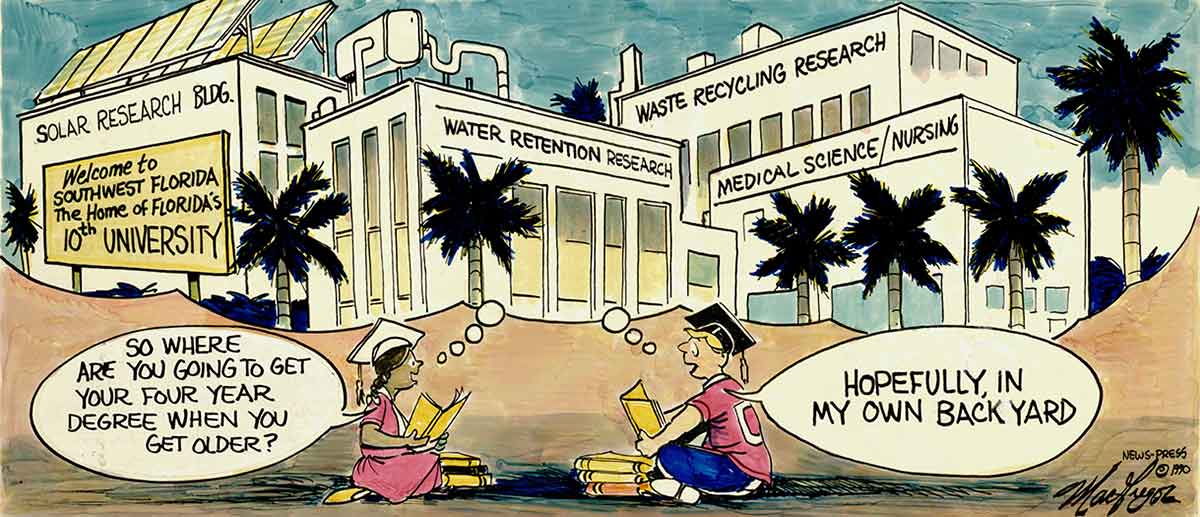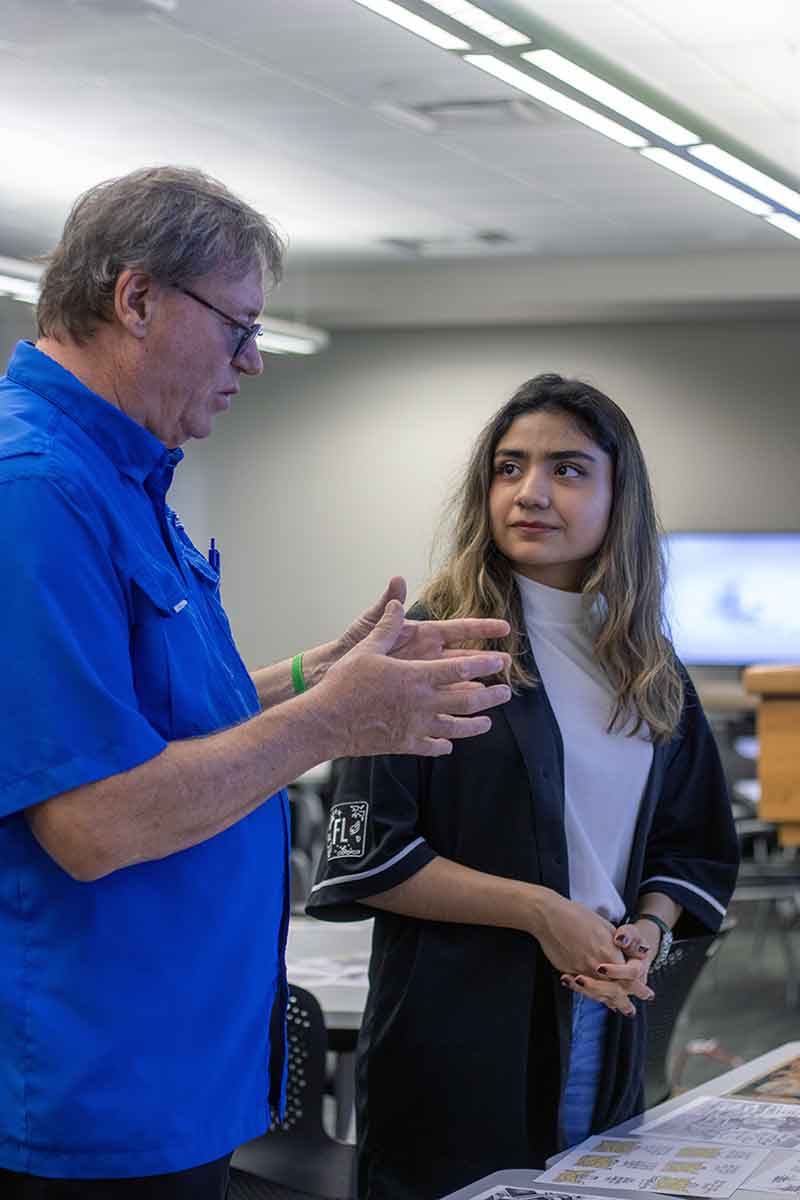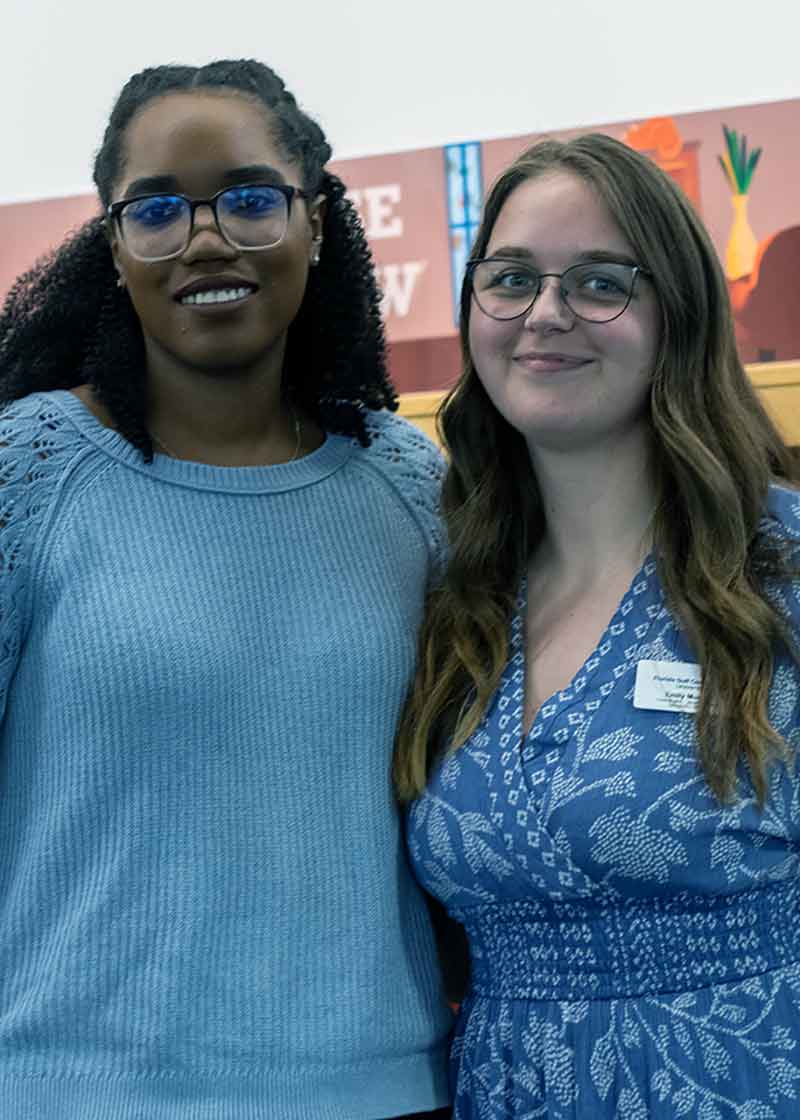Drawn to the University Archives: Finding inspiration in Southwest Florida’s history
When Southwest Florida cartoonist Doug MacGregor donated a collection of his work to Florida Gulf Coast University, he hoped it might one day inspire future artists.
He didn’t have to wait very long.
This spring, art major Aileen Salas discovered MacGregor’s original cartoons while working on a class project.
“Doug’s collection immediately caught my eye because his artwork had a very nostalgic feel to it,” said Salas. “I could’ve sworn I’d seen one of his cartoons before.”
Since the Naples native has been drawing and reading cartoons since she was 8 years old, it’s possible she had seen MacGregor’s work before. An artist for more than 40 years, he served as editorial cartoonist for The News-Press from 1988-2011, creating thousands of works documenting and commenting on local and national politics, natural disasters, environmental issues and the everyday oddities of life in Florida. He donated drawings and original prints to FGCU’s University Archives and Special Collections in 2022, ensuring that future generations could explore Southwest Florida through his ink-stained lens.


Salas gravitated to a series MacGregor created during the 2004 hurricane season, when four major storms hit Florida.
“They’re so well made that I can still relate to some of them 20 years later,” she said. MacGregor’s collection in the archives showed her how a working, modern artist can use their skills “in ways I’d never imagine” just reading about it in a textbook.
A treasure trove of art at FGCU
Hannah Harley is an assistant professor of art and community engagement in the Bower School of Music and the Arts and the Shady Rest Institute on Positive Aging. She teaches a variety of courses, including the one that helped Salas discover MacGregor’s work, “History of Photography.”
“Many students had not experienced the richness of material items like silver gelatin prints, cyanotypes or tintypes. We could talk about great photographs, but the idea that students could really experience photographs beyond digital was important to me,” Harley said.
Harley was initially interested in the University Archives’ Charles A. Ray photojournalism collection. The NBC photojournalist captured many historic events throughout the second half of the 20th century and donated his collection to FGCU’s library in 2002.
Harley approached staff members at the University Archives, who were eager to partner with her and her students. But they wanted to give her students more than just a show-and-tell tour.
“They really yearned for creative projects to be made from the collections,” Harley said.
She and her students met with Victoria Jones, university archivist, and Emily Murray (‘22, anthropology), archives coordinator. They introduced the students to the MacGregor collection.
“Each of the comics capture and convey a particular moment in Southwest Florida history. They’re always fun to share because most people immediately recognize some of the history that’s being referenced in an image,” Jones said.
“The cartoons in Doug MacGregor’s collection help provide a different way of engaging with primary sources — one that distills complex issues, whether it’s environmental issues or government policy — into something immediate and visual,” Murray said. “By looking at one of these cartoons, researchers can trace public sentiment and see how attitudes have shifted — or in some cases, how they haven’t changed at all.”
Salas was one of several students in Harley’s class who requested a closer look at MacGregor’s collection. Salas asked so many questions that Murray suggested she meet the artist and arranged an introduction. “He’s very collaborative and has expressed an interest in his collection being used by students,” Murray said.
“The more time Aileen spent with the collection, the more defined her work became,” Harley said. “She was creating something new from this collection, and it was inspiring her to find her voice. For Aileen, this project made a huge difference in her embracing telling her own stories through cartoons.”
A little local color
For Harley and the archives staff, introducing students to the archives also emphasized the importance of learning and understanding regional history.
“Local history is made by everyday people who have a hope for what tomorrow might be, and they worked hard to make it happen. I think the students learn that they’re not so removed from history — it’s happening right now, right in front of you,” Harley said.

“The Doug MacGregor collection is excellent in documenting what it’s like to live in Southwest Florida,” Salas said. “I liked the range of Doug’s storytelling and how he uses it to express concerns and criticisms in such a lighthearted yet concise manner.”
From carefully considering MacGregor’s cartoons and the conversations she had with him, she knew she wanted to keep her storytelling simple. MacGregor even taught her some tricks of the trade that influenced her use of dialogue and labelling.
“During his career, Doug had complete artistic freedom and was allowed to choose what he wanted to draw about. He mentioned that I should consider using my own experiences for ideas, how they’re just as valuable. It definitely changed how I thought about cartooning and creating in general,” Salas said. “With the beautiful artworks and installations you see in the gallery, I used to think the work I make here must take itself just as seriously in style. But really, it’s sincerity that drives it, and that’s what I see in Doug’s cartoons.”
His cartoons about student life inspired her project, “Time After Tide.” Her hand-drawn and painted cartoons chronicle her experiences as an FGCU student. The title is a combination of the phrases “time and tide wait for no man” and “time after time.”
“With classes, service-learning and other big projects, time moves pretty quickly, and it feels like there’s little opportunity to acknowledge the mundane part of college life,” Salas said. “Every student is following a different path, but I’m pretty certain that we all have more in common than we think.”
Salas’ realization mirrors the goals Harley set for the course: encouraging students to think critically, create authentically and connect with the art world around them.
“One of the things I love most about FGCU is its commitment to the community and experiential learning for our students,” Harley said.
Latest FGCU News
- Spring 2025 President’s and Dean’s Lists honor top scholarsFlorida Gulf Coast University honors its top scholars each semester by naming undergraduate students to the President’s or Dean’s lists....
- Tropical careers take root at the Naples Botanical GardenOn the first Friday of most months at the Naples Botanical Garden, conservationists from across Southwest Florida gather to share...
- One of FGCU’s first engineering grads champions sustainabilityIt isn’t easy being James Evans these days. As chief executive officer of the Sanibel-Captiva Conservation Foundation, Evans is responsible...
- FGCU celebrates $22 million gift, the largest donation in its historyThe patient, Mr. Jones, lies on his back under a blue blanket in a hospital bed, blinking up at the...
- Lights, camera, connection: ROCK of Ages builds intergenerational bridgesCasandra Casadevalle didn’t think she had a shot at the Fulbright Program when she first thought about applying during her...
- FGCU business students witness history at Berkshire Hathaway annual meetingNine class of 2025 standouts have been inducted into Florida Gulf Coast University’s Hall of Fame, the highest recognition awarded to students. The...













